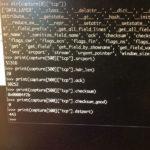Documentation
Resources
Overview: For this week, my goal was to poke around with Wireshark and learn a bit more about networks. I decided I would also try using pyshark, which is a python wrapper around Wireshark’s command-line utility tshark. Originally I had thought I would pipe some data into Processing to do some viz with it, but at the end of the week realized that Processing already had Carnivore as a library, which allowed packet for in-Porocessing packet sniffing. Wish I’d thought of looking to see if that existed earlier. But oh well? Its nice to know it exists, and I will explore it in the future.
What I ended up doing instead was writing some utility functions to comb through captured data and return the most active of whatever items you send through it. Pyshark has some good ways to dig down into packets, but it can also just grabs all the summaries. So if you want to compare traffic, look for protocols, or just poke around, you can toss together some basic functions to do so.
I think in the end I liked doing the utility functions more than the idea of visualizing it. I would get to the point of having a dataset, and instead of moving on, would go back and dig around in the packets a bit more.
https://youtu.be/yheUVI2p7sM
Of Note: One thing to note though is that LiveCapture in pyshark can sometimes be borked in OSX. Wireshark (and other sniffers) require read access to “/dev/bpf*” which is usually owned by root/wheel. When you use Carnivore, you have to change the permissions on this to 777, which is…very permissive. You will have to do this each time. Wireshark creates a user group, and adds the person who installed wireshark to this group. So pyshark should be able to use tshark under your user without this extra step.
If you can’t get it working then either you need different permissions, or like me, you are trying to read a networking interface that doesn’t exist…because you weren’t paying attention. Then ended up in a 1 day rabbit hole…but I learned some things about what’s depreciated in the OSX system.
Other things I rediscovered: using man pages, and using python’s dir() function. Which is really useful when you want to know what kind of methods you can use on something.









